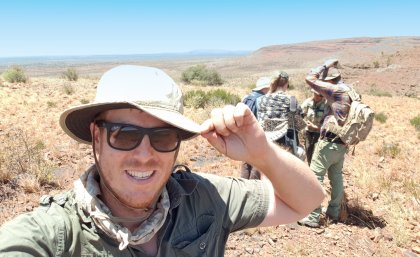
The discovery of unexpected artefacts in Africa’s Kalahari Basin has challenged conventional knowledge about the beginnings of human culture and innovation.
A Queensland-led research team found crystals and ostrich shell fragments at Ga-Mohana Hill North Rockshelter - one of only a few well-preserved archaeological sites in the interior of southern Africa.
University of Queensland archaeologist Dr Benjamin Schoville said advanced dating techniques applied to a site 600 kilometres inland revealed artefacts from 105,000 years ago that were previously only found near coastlines and much earlier than previously associated with the region.
“The cultural and environmental significance of the project brings into question many long-held ideas about the early development of our species being defined by, and confined to, coastal environments,” Dr Schoville said.
“What we found and how we dated the site confirmed that not only was the semi-arid region known as the Kalahari Desert considerably wetter 105,000 year ago, but also that cultural and technological behaviours that define our species were in place.”
Dr Schoville said the artefacts were evidence of complex symbolic behaviours where humans collected and kept items for their aesthetic as well as functional value, much earlier than previously thought.
“Archaeological and geological fieldwork allowed us to piece together this story,” he said.
“The closest source of those crystals is more than two kilometres away, so the best explanation is that the people living there deliberately collected them.
“The crystals were found close together, which suggests special use of the shelter.
“Interestingly, the site is also used to practise ritual activities today.”
The methods used to reconstruct the past environment have also revealed new possibilities for archaeological research.
The uranium-thorium process is routinely applied to cave deposits like stalagmites and flowstone but rarely to tufa – the calcium carbonate deposits formed from water leaking out of cracks in bedrock.
“Dating tufas is not straightforward,” Dr Schoville said.
“Unlike protected caves, tufa forms in the open where sunlight, dust and debris can contaminate the ages, and it took several years of very careful work by my colleagues to get around these problems.”
The research team’s methods considered the ongoing cultural, spiritual and heritage significance of Ga-Mohana Hill well as the potential for future excavations.
Dr Schoville described the process for an article in The Conversation.
The international team is led by Dr Jayne Wilkins from Griffith University’s Australian Research Centre for Human Evolution and includes researchers from Victoria, South Africa, Austria, the UK and Canada.
The research is published in Nature (DOI: 10.1038/s41586-021-03419-0).
Media: Dr Benjamin Schoville, b.schoville@uq.edu.au, +61 7 3365 3314.
.jpg)












